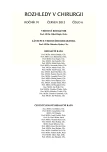The significance of biological intracranial meningioma behaviour for their long-term management
Authors:
D. Netuka 1; F. Kramář 1; T. Belšan 2; P. Hrabal 3; I. Černotová 4; S. Ostrý 1; O. Bradáč 1; M. Preiss 5; V. Beneš 1
Authors‘ workplace:
Neurochirugická klinika 1. LF UK, a ÚVN a IPVZ, přednosta: Prof. MUDr. Vladimír Beneš, DrSc.
1; Radiodiagnostické oddělení 1. LF UK, a ÚVN, primář: MUDr. Tomáš Belšán, PhD.
2; Oddělení patologie 1. LF UK, a ÚVN, primář: MUDr. Petr Hrabal
3; Synlab czech, vedoucí laboratoře imunologie a infekční sérologie: Ing. Štěpánka Luxová
4; Psychiatrické centrum Praha-Bohnice, ředitel: Prof. MUDr. Cyril Höschl, DrSc.
5
Published in:
Rozhl. Chir., 2012, roč. 91, č. 6, s. 322-326.
Category:
Original articles
Overview
Introduction:
From the histological point of view, most meningiomas are benign tumours. Nevertheless, their recurrence is quite frequent, and identifying the risk factors for recurrent disease is of utmost importance.
Material and methods:
Prospective study, patients operated on in the period 2/2008–9/2009. Inclusion criteria for enrolment into the study: age 18–70 years, good health status, and previously untreated solitary intracranial meningioma. Evaluation of clinical, surgical, MRI findings and vascular endothelial growth factor serum levels (prior to procedure, 3 months after, 12 months after, 24 months after procedure and at the time of the last follow-up in 11/2011) was performed. Immunohistochemical analysis of histological samples was carried out. Further treatment (wait and see, redo surgery, treatment with radiation using the Leksell Gamma Knife, external radiotherapy) was recorded in case of a positive follow-up MRI finding (recurrent disease, progression of residual tumour).
Results:
A total of 50 consecutive patients (34 women and 16 men) were included into the study. Average age at the time of surgery was 59.2 years (range 27–75 years). Radical resection with no residual tumour left was achieved in 35 cases. Histological analysis showed grade I meningioma in 45 cases and grade II (atypical) meningioma in 5 cases. Correlation between E-cadherin expression and recurrent meningioma was proved by immunohistochemical examinations; in the remaining investigations, however, such a correlation was not found. No correlation was detected between the serum vascular endothelial growth factor level and the expression of vascular endothelial growth factor in immunohistochemical investigation. A correlation was found between the expression of vascular endothelial growth factor in immunohistochemical investigation and peritumoural oedema. The tumour recurred in 5 cases.
Conclusions:
On the basis of our results as well as literature findings we can conclude that all the patients after meningioma surgery need to be carefully followed for the rest of their life by repeated MRI invetigations.
Key words:
meningioma – recurrence – risk factors
Sources
1. Mathiesen T, Lindquist C, Kihlström L, et al. Recurrence of cranial base meningiomas. Neurosurgery 1996;39(1):2–7.
2. Philippon J. Operability of intracranial meningioma. Bull Acad Natl Med 2003;187(3):591–8.
3. Simpson D. The recurrence of intracranial meningiomas after surgical treatment. JNNP 1957;20(1):22–39.
4. Kozler P, Beneš V, Netuka D, Kramář F, Charvát F. Nitrolební meningiomy; standardní diagnostický postup a výsledky operační léčby. Rozhledy v chirurgii 2006;85(9):431–435.
5. ASA Physical Status Classification System,
http://www.asahq.org/For-Members/Clinical-Information/ASA-Physical-Status-Classification-System.aspx
6. Karnofsky DA, Burchenal JH. The Clinical Evaluation of Chemotherapeutic Agents in Cancer. In: MacLeod CM (Ed), Evaluation of Chemotherapeutic Agents. Columbia Univ Press 1949 : 196.
7. Louis DN, Ohgaki H, Wiestler OD, et al. The International Agency for Research on Cancer. WHO Classification of Tumours of the Central Nervous System, IARC Press, Lyon, France 2007.
8. SF-36.org, http://www.sf-36.org/tools/sf36.shtml
9. Yamasaki F, Yoshioka H, Hama S, Sugiyama K, Arita K, Kurisu K. Recurrence of meningiomas. Cancer 2000;89(5):1102–10.
10. Loebig M, Klement J, Schmoller A, Betz S, Heuck N, Schweiger U, Peters A, Schultes B, Oltmanns KM. Evidence for a relationship between VEGF and BMI independent of insulin sensitivity by glucose clamp procedure in a homogenous group healthy young men. PLoS One 2010;5(9):e12610.
Labels
Surgery Orthopaedics Trauma surgeryArticle was published in
Perspectives in Surgery

2012 Issue 6
Most read in this issue
- Treatment of an asymptomatic splenic cyst using percutaneous drainage
- Meckel´s diverticulum in adults – our five-year experience
- Laparoscopic appendectomy in pregnancy – a case report
- Percutaneous interspinous dynamic stabilization (In-Space) in patients with degenerative disease of the lumbosacral spine – a prospective study
